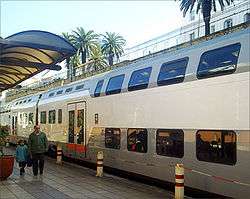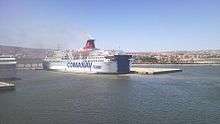Transport in Morocco
There are around 56,986 km (35,409 mi) of roads (national, regional and provincial) in Morocco.[1] In addition to 1,588 km (987 mi) of highways.[2]
The Tangier–Casablanca high-speed rail link marks the first stage of the ONCF’s high-speed rail master plan, pursuant to which over 1,500 km (930 mi) of new railway lines will be built by 2035. The high speed train - TGV - will have a capacity of 500 passengers and will carry 8 million passengers per year. The work on the High Speed Rail project was started in September 2011.[3] Construction of infrastructure and delivery of railway equipment will end in 2014 and the HSR will be operational by December 2015.[4]

Government policy
With billions of dollars committed to improving the country's infrastructure, Morocco aims to become a world player in terms of marine transport. The 2008-2012 investment plan aims to invest $16.3 billion and will contribute to major projects such as the combined port and industrial complex of the Tanger-Med and the construction of a high-speed train between Tangier and Casablanca. The plan will also improve and expand the existing highway system and expand the Casablanca Mohammed V International Airport. Morocco’s transport sector is one of the kingdom’s most dynamic, and will remain so for years to come. The improvements in infrastructure will boost other sectors and will also help the country in its goal of attracting 10 million tourists by 2010.
Railways

1907 km 1,435 mm (4 ft 8 1⁄2 in) standard gauge, 1003 km electrified with 3 kV DC.
High speed lines

There are plans for several high-speed lines. Work by ONCF began in September 2011 on a first section from Tangier to Kenitra.[5] There are plans to construct two core lines, one from Tangier in the north via Marrakesh to Agadir in the south, and a second from Casablanca on the Atlantic to Oujda on the Algerian border. If all of these plans will be approved, the 1,500 kilometres of track may take until 2035[6] to complete at a cost of around 100 billion dirhams ($10 billion).
Potential speed gains are large, with travel time from Casablanca to Marrakesh down from 3 hours to 1:20, and from the capital Rabat to Tangier from 4:30 to 1:30.[7]
The second High-Speed Rail (HSR) which is planned to be built after Tangier-Kenitra is the HSR Marrakech-Essaouira (180 km)[8] followed by a new HSR Rabat-Meknes (130 km).[9] The last high-speed lines will connect these two old empire cities to the Atlantique coast in less than one hour instead of two hours now.
The current high-speed line Tangier-Kenitra under construction was impacted by delays resulting from issues about land acquisitions cause this operation was performed by different local gouvernors, in order to avoid such delays on the next high-speed rail Marrakech-Essaouira it is the national railway compagny ONCF that was given the greenlight to start the land acquisition and expropriation procedure.[10]
Other new routes
A new railway connecting Nador to the existing network at Taourirt was finished in 2010, after it had been under construction since 2007.[11]
Tramways
- Rabat-Salé tramway (2011)
- Casablanca Tramway (2012)
Roads
As of 2006 there were around 57625 kilometres of roads (national, regional and provincial) in Morocco,[12] and an additional 1588 kilometers of highways (July 2015).
Principal national roads:
- National Route 1 (Morocco)
- National Route 2 (Morocco)
- National Route 3 (Morocco)
- National Route 4 (Morocco)
- National Route 5 (Morocco)
- National Route 6 (Morocco)
- National Route 7 (Morocco)
- National Route 8 (Morocco)
- National Route 9 (Morocco)
- National Route 10 (Morocco)
- National Route 11 (Morocco)
- National Route 12 (Morocco)
- National Route 13 (Morocco)
- National Route 14 (Morocco)
- National Route 15 (Morocco)
- National Route 16 (Morocco)
Highways
- A1 Rabat-Tangier (223 km)
- A2 Rabat-Fes (206 km)
- A2 Fes-Oujda (321 km)
- A3 Casablanca-Rabat (65 km)
- A4 Tangier-Tanger Med (54 km)
- A5 Casablanca-El Jadida (114 km)
- A6 Tetouan-Fnideq (28 km)
- A7 Casablanca-Marrakesh (197 km)
- A7 extension to Agadir (233 km)
- A11 Berrechid-Benni Mellal (172 km)
Major airports
- Agadir -- Agadir–Al Massira Airport: (AGA) Flights to most major European cities.
- Al Hoceima -- Cherif Al Idrissi Airport: (AHU) Flights to Brussels, Charleroi and Amsterdam
- Casablanca -- Mohammed V International Airport: (CMN) Arrivals and departures to worldwide destinations.
- Fez -- Fes–Saïss Airport: (FEZ) Flights to Europe and Casablanca
- Laayoune -- Hassan I Airport: (EUN) Flights to Agadir, Casablanca, Dakhla and Las Palmas.
- Marrakech -- Marrakesh Menara Airport: (RAK) Flights all major international airports in Western Europe
- Nador -- Nador International Airport: (NDR) Flights to Amsterdam, Brussels, Casablanca, Cologne, Düsseldorf and Paris.
- Oujda -- Angads Airport: (OUD) Flights to Amsterdam, Casablanca, Marseille and Paris.
- Ouarzazate -- Ouarzazate Airport: (OZZ) Flights to Casablanca and Paris.
- Rabat -- Rabat–Salé Airport: (RBA) Flights to Paris and Tripoli.
- Tangier -- Tangier Ibn Battouta Airport: (TNG) Flights all major international airports in Western Europe
National airlines
Merchant marine
total: 35 ships (1,000 GRT or over) by type:
- cargo ship 3,
- chemical tanker 6,
- container ship 8,
- passenger/cargo ship 12,
- petroleum tanker 1,
- refrigerated cargo ship 1,
- roll-on/roll-off 4
Foreign-owned: 14 (France 13, Germany 1) (2007)
- Registered in other countries: 4 (Gibraltar)
Maritime companies

- Acciona Trasmediterránea
- Baleària
- Comanav
- Comarit
- FerriMaroc
- FRS Iberia
- Grandi Navi Veloci
- Grimaldi Lines
- International Maritime Transport Corporation
- Inter Shipping
- Naviera Armas
Sports car
References
- ↑ "Le Secteur Routier" (PDF). mtpnet.gov.ma. Archived from the original (PDF) on 1 May 2011. Retrieved 2010-06-02.
- ↑ (French) Les Autoroutes du Maroc. Adm.co.ma. Retrieved on 2013-07-29. Archived 13 July 2015 at the Wayback Machine
- ↑ RFI. "Maroc : inauguration des travaux du premier TGV d’Afrique en présence de Nicolas Sarkozy". RFI. Retrieved 16 October 2011.
- ↑ "Morocco to Launch High Speed Train". Retrieved 2010-06-02.
- ↑ Ceremony launches Tanger–Casablanca high speed project, Railway Gazette, 29 September 2011.
- ↑ $10 billion for the high speed rail program
- ↑ Khaleej Times Online - Morocco plans Arab world's first high-speed train Khaleej Times, 15 September 2006.
- ↑ A High speed line From Marrakech to Essaouira "Railway Ghazette", October 1st 2015
- ↑ A HSR Rabat-Meknes through Khemisset
- ↑ Marrakech-Essaouira HSR : Greenlight given to ONCF for land expropriation
- ↑ Times Atlas of the World, 2007, p. 83
- ↑ CIA World Factbook
External links
| ||||||||||||||||||||||||||||||||||||||||||||||||||||||
| ||||||||||||||
![]() This article incorporates public domain material from websites or documents of the CIA World Factbook.
This article incorporates public domain material from websites or documents of the CIA World Factbook.